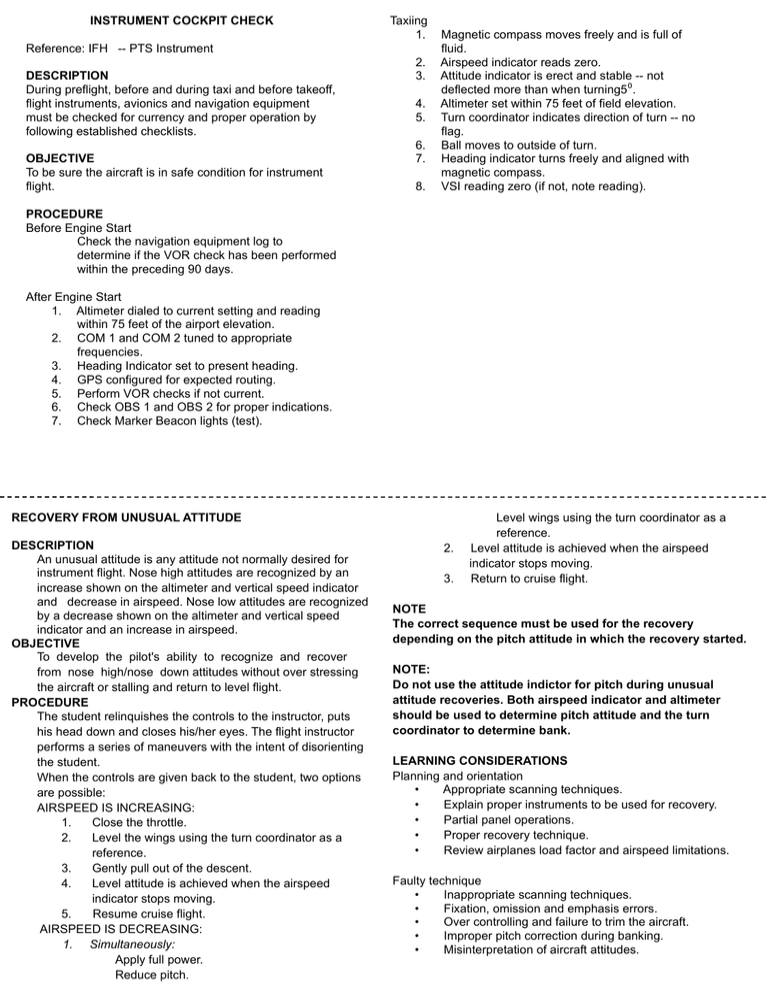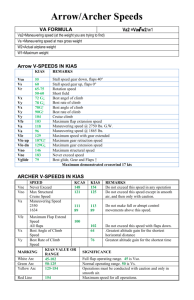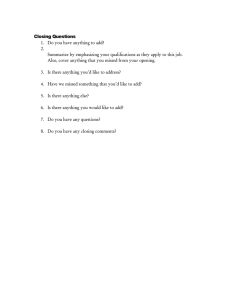INSTRUMENT COCKPIT CHECK Reference: IFH -
advertisement

INSTRUMENT COCKPIT CHECK Taxiing 1. Reference: IFH -- PTS Instrument DESCRIPTION During preflight, before and during taxi and before takeoff, flight instruments, avionics and navigation equipment must be checked for currency and proper operation by following established checklists. OBJECTIVE To be sure the aircraft is in safe condition for instrument flight. 2. 3. 4. 5. 6. 7. 8. Magnetic compass moves freely and is full of fluid. Airspeed indicator reads zero. Attitude indicator is erect and stable -- not deflected more than when turning5⁰. Altimeter set within 75 feet of field elevation. Turn coordinator indicates direction of turn -- no flag. Ball moves to outside of turn. Heading indicator turns freely and aligned with magnetic compass. VSI reading zero (if not, note reading). PROCEDURE Before Engine Start Check the navigation equipment log to determine if the VOR check has been performed within the preceding 90 days. After Engine Start 1. Altimeter dialed to current setting and reading within 75 feet of the airport elevation. 2. COM 1 and COM 2 tuned to appropriate frequencies. 3. Heading Indicator set to present heading. 4. GPS configured for expected routing. 5. Perform VOR checks if not current. 6. Check OBS 1 and OBS 2 for proper indications. 7. Check Marker Beacon lights (test). RECOVERY FROM UNUSUAL ATTITUDE DESCRIPTION An unusual attitude is any attitude not normally desired for instrument flight. Nose high attitudes are recognized by an increase shown on the altimeter and vertical speed indicator and decrease in airspeed. Nose low attitudes are recognized by a decrease shown on the altimeter and vertical speed indicator and an increase in airspeed. OBJECTIVE To develop the pilot's ability to recognize and recover from nose high/nose down attitudes without over stressing the aircraft or stalling and return to level flight. PROCEDURE The student relinquishes the controls to the instructor, puts his head down and closes his/her eyes. The flight instructor performs a series of maneuvers with the intent of disorienting the student. When the controls are given back to the student, two options are possible: AIRSPEED IS INCREASING: 1. Close the throttle. 2. Level the wings using the turn coordinator as a reference. 3. Gently pull out of the descent. 4. Level attitude is achieved when the airspeed indicator stops moving. 5. Resume cruise flight. AIRSPEED IS DECREASING: 1. Simultaneously: Apply full power. Reduce pitch. 2. 3. Level wings using the turn coordinator as a reference. Level attitude is achieved when the airspeed indicator stops moving. Return to cruise flight. NOTE The correct sequence must be used for the recovery depending on the pitch attitude in which the recovery started. NOTE: Do not use the attitude indictor for pitch during unusual attitude recoveries. Both airspeed indicator and altimeter should be used to determine pitch attitude and the turn coordinator to determine bank. LEARNING CONSIDERATIONS Planning and orientation • Appropriate scanning techniques. • Explain proper instruments to be used for recovery. • Partial panel operations. • Proper recovery technique. • Review airplanes load factor and airspeed limitations. Faulty technique • Inappropriate scanning techniques. • Fixation, omission and emphasis errors. • Over controlling and failure to trim the aircraft. • Improper pitch correction during banking. • Misinterpretation of aircraft attitudes. WACO, TEXAS AL-439 (FA ) VORTAC ACT 1 5.3 VOR RWY 14 513 516 TDZE 141^ 10 Chan 5896 Rwy Idg APP CRS Apt Elev (ACT) WACO RGNL MIS ED AP ROACH: Climbing right urn to 40 0 via R-164 ASR to BOSEL/INT 14.0 DME and hold. 1 9.3 257.8 127.65 2 7.125 (CTAF) R-328 2 5 0 0 MAJER A C T ACT 10 103^ 12 .95 N o P T A r c 148^ (10) N rc o P T 1 0 170 283^ (IAF) A 1049 OVFAC A C T 148^ 1 0 2 7 0 0 UNICOM 121.9 L ACT 10 1049 R-050 (IAF) R-271 WAKMO ACT IAF WACO 1 5.3 ACT 141^ ACT 10 Chan 10 638 SC-3, 26 AUG 2010 to 23 SEP 2010 123.85 GND CON WACO TOWER WACO AP CON ATIS 658 IL IT IE S F A E R 1021 C F A 1 C R-164 0 N M 1049 IL IT I E S 608 E R O U E T E D F 1049 A C T S A 2 5 E N M 164^ M ELEV 250 N 516 D 34 ^ BOSEL R-027 090^ ACT 14 270^ TEMPLE 19 1 0.4 TPL 360 545 141^ 3.1 NM Chan 41 14 V 40 0 BOSEL Remain 14 ACT 6596 X 150 VORTAC within 10 NM A 5 from FAF TDZE 513 R-164 5896 X 150 328^ 2.1 ACT 1 NM to 250 170 VGSI and descent angles not coincident. 3.1 1 608 387 (40 -1) 920-1 404 (50 -1) 980-1 464 (50 -1) REIL Rwy 14 1 NM C B 90 -1 S-14 Amdt 23 10 42 32 TCH 59 2.1 NM WACO, TEXAS 56 V V 141^ 3.42^ A CATEGORY CIRCLING 589 ACT RW14 148^ 90 -1 DME ARCS 1080-2 980-1 387 (40 -1 ) 1 1 2 564 (60 -2) L MIRL Rwy 14-32 4 1 L FAF to MAP 3.1 NM 4 Knots 2 1 464 (50 -1 ) HIRL Rwy 1-19 D Min:Sec 60 3:06 90 2:04 120 1:3 150 180 1:14 WACO RGNL DESCRIPTION VOR RWY 14 The airplane is maneuvered onto a specific arc off a VOR facility or GPS waypoint and maintains that arc by adjusting for wind. 31^37’N-97^14’W OBJECTIVE To achieve the skill and knowledge required to intercept and track DME arcs. PROCEDURE • Tune and identify the navaid used as a primary reference for the arc. • Proceed inbound or outbound on the cleared course or heading. • Determine initial heading for direction of arc. • When within .5 nm of the desired arc, commence a standard rate turn in the direction of the arc. • Turn 90⁰ from the radial the aircraft is on. • Once established on the arc, twist the OBS 10⁰ right or left (depending upon direction of arc) and turn 10⁰ right or left (depending upon direction of arc) • When the CDI centers, twist the OBS 10⁰ in the appropriate direction and turn 10⁰ in appropriate direction (“turn 10, twist 10”) • Repeat the procedure until reaching desired radial, turn inbound or outbound according to clearance. • Adjust heading to compensate for any wind drift. 1:02 (ACT) NOTE: For every 1 NM inside the arc, correct outside 5⁰. For every 1 NM outside the arc, correct inside 10⁰ LEARNING CONSIDERATIONS Planning and orientation • Arcing procedures: VOR vs. GPS. • Recommended arcing airspeed is 100 kts. • Establishing techniques for wind-drifts. Faulty Technique • Failure to lead the turn onto the arc. • Failure to remain on the arc. • Inadequate wind correction. • Inadequate situational awareness. • Inappropriate airspeed. HOLDING PROCEDURES DESCRIPTION Holding is maneuvering an airplane along a predetermined flight path within prescribed airspace limits with respect to a specified fix. OBJECTIVE To achieve the skill and knowledge required to enter and remain within a published or non-published holding pattern. THE 5 "T"s This memory aid should be referenced any time when crossing a fix inbound on an approach or executing a hold procedure. TURN: Roll the aircraft into a standard rate mm. TIME: Activate the clock or timer to time the mm or the leg. TWIST: Twist the heading bug and the bearing selector to reflect the course. THROTTLE: Verify throttle setting to maintain airspeed. TALK: Announce entering the hold or procedure turn inbound. PROCEDURE 1. After receiving the holding clearance determine holding entry. 2. Tune and identify the navaid used as a primary reference. 3. Slow to holding speed within 3 minutes of the holding fix. 4. Determine wind and groundspeed correction before entry. 5. Upon reaching the fix, fly the selected entry and report the time, altitude and fix to ATC. 6. When established in the hold, cross fix and begin the outbound turn (standard rate). 7. Start the outbound leg, timing when abeam the fix or "TO/ FROM" ambiguity flip. 8. After one minute, turn inbound (standard rate). Start time at wings level after turn. 9. Adjust the outbound time to make the next inbound leg one minute. 10. When flying outbound use three times the wind correction you used to track inbound. NOTE: The Heading indicator must be aligned with the compass after the completion of each turn in the hold. LEARNING CONSIDERATIONS Planning and orientation • Standard and non-standard holding patterns, wind-drift and timing corrections. • Published vs. non-published holding patterns. • Various holding entries. • 5Ts. • Expect further clearance (EFC). Faulty Technique • Faulty hold entry. • Failure to correct for wind. • Failure to maintain situational awareness. Instrument Take Off Procedure 1,000’ AGL • Transition to cruise climb 500’ AGL • Confirm Gear Up • Confirm Flaps Up • Climb checklist Before Takeoff • Safety briefing • Takeoff checklist DESCRIPTION Takeoff and climb while turning at the appropriate altitudes and accomplishing checklists at appropriate times. OBJECTIVE To achieve the skill and knowledge necessary to takeoff and climb while following IFR procedures PROCEDURE • Complete takeoff safety briefing and takeoff checklist. • Retract gear after positive rate is established (tap brakes before retraction). • Climb at Vy for first 1000’. • Turn to assigned heading at 400’ AGL or as specified in an obstacle or area Departure Procedure. • Complete climb checklist at 500’ AGL • At 1000’ AGL transition to cruise climb speed (113) and set cruise climb power. First turn • At 400’ AGL -or• As specified in an obstacle DP Precision Approach 10 Miles – 10 Minutes Prior to the Approach • ATIS received • Approach selected and briefed • 16” MP 3-5 miles out Missed Approach • “Going Missed” • 5 “C”s • Gear Up at positive rate of climb • Climb at 100 KIAS • Advise Tower of Missed and Intentions • Climb Check Localizer Intercept • ”Localizer Alive” • Speed 105 KIAS • “Glide Slope Alive” One Dot Below Glide Slope Intercept • Calculate required VSI based on GS • Gear down • Reduce 2” MP for 500 FPM descent • 100 KIAS Final Approach Fix • Start Time • “Final Fix” • GUMPS • Complete landing check list DESCRIPTION A precision approach procedure shall provide vertical guidance as well as horizontal guidance along a specified path. OBJECTIVE Develop the knowledge and skill necessary to execute precision approaches. APPROACH SETUP: • Where are we? (Situational Awareness) • ATIS - (AWOS or ASOS) Current airport information. • Radios set Comm 1 / Comm2. • Nav Aids set (Nav l / Nav 2). • Briefing - Brief the approach plate starting at the top. • Intentions - Brief intentions; straight in approach, circle to land, or low approach. • Flows / Checklist (Before Landing). Prior To Initial Approach Fix • Comply with ATC clearance. • Complete instrument approach setup. • Reduce power for approach speed (3 min. prior to ETA). • Crossing the IAF, complete the 5 "T”s (if full approach). • Proceed outbound for hold or procedure turn (if full approach). Procedure Turn Inbound • Upon completion of the procedure turn, intercept the glide slope. • One dot below glide slope, gear down. • Reduce power 2” MP, descend at calculated fpm (5x the groundspeed), and maintain Approach speed. • • • • • “200’ above Minimums” • “100’ above Minimums” • “Minimums, Runway/Approach Lights in Sight, or Negative Contact” Adjust pitch and power, as necessary to maintain the glide slope and VSI at the desired approach speed. Maintain course by establishing a wind correction heading. For deviations from the course and glide slope, make SMALL corrections to re-intercept. At DA transition to a normal landing, or Execute the missed approach procedure. LEARNING CONSIDERATIONS Planning and orientation: • Types of precision approaches • ATC requirements, requests and clearances • Circling approaches • Approach set-up and flows/checklists. • Runway environment. • Positional awareness. • Missed approach procedures. Faulty technique: • Inadequate power settings • Faulty descent rate. • Failure to establish correct descent rate and airspeed • Failure to achieve DA • Failure to go missed • Failure to extend flap / gear setting at glideslope intercept • Failure to do the five “T”s Non-Precision Approach At or Abeam the IAF • 5 “T”s • Approach Clearance Received • Speed 105 KIAS 10 Miles – 10 Minutes Prior to the Approach • ATIS received • Approach selected and briefed • Calculate VDP • 16” MP 3-5 miles out Radar Vectored Approach Procedure Turn Outbound • 5 “T”s • Set up inbound course FAF • “Final Fix, descending to minimums” • Start time • Gear down, 12” MP • GUMPS • 800 FPM with headwind, 1200 FPM with tailwind Missed Approach • “Going Missed” • 5 “C”s • Gear Up at positive rate of climb • Climb at 100 KIAS • Advise Tower of Missed and Intentions • Climb Check Joining Final • Descend to final altitude • State distance to FAF Descent Established • Landing check complete DESCRIPTION A non- precision approach provides horizontal course guidance with no glide slope information along a specified path. OBJECTIVE Develop the knowledge and skill necessary to execute nonprecision approaches. APPROACH SETUP: • Where are we? (Situational Awareness) • ATIS - (AWOS or ASOS) Current airport information. • Radios set Comm 1 / Comm2. • Nav Aids set (Nav l / Nav 2). • Briefing - Brief the approach plate starting at the top. • Intentions - Brief intentions; straight in approach, circle to land, or low approach. • Calculate VDP • Flows / Checklist (Before Landing). Prior to Initial Approach Fix • Comply with ATC clearance. • Complete instrument approach setup. • Reduce power for approach speed (3 min. prior to ETA). • Crossing the IAF, complete the 5 "T”s (if full approach). • Proceed outbound for hold or procedure turn (if full approach). Procedure Turn Inbound • Upon completion of the procedure turn, fly the approach profile. • For step downs, reduce RPM to descend 800 fpm and maintain approach speed. After Visual Contact • Flaps as required • Blue line • “200’ above minimums” • “100’ above minimums” • “Minimums—(time/distance) to MAP” • • • • • At FAF, gear down (if applicable) and reduce power to the desired rpm, descend at 800 fpm if headwind, 1200 (or as required by ground speed) fpm if tail wind. Maintain course by establishing a wind correction heading. For deviations from the course, make SMALL corrections to re-intercept. Prior to MDA, initiate level off to arrest descent by MDA. Maintain MDA until in normal position to descend or, execute the missed approach procedure. If landing, slow to final approach speed. LEARNING CONSIDERATIONS Planning and orientation: • VOR, LOC, LOC BC, GPS/RNAV, NDB, or ASR approaches. • ATC requirements, requests and clearances. • Approach charts and procedures. • Approach set-up and flows/checklists. • Runway environment. • Positional awareness. • Missed approach procedures. Faulty technique: • Inadequate power settings. • Faulty descent rate. • Failure to maintain approach speed. • Failure to maintain level-off altitudes. • Failure to achieve and maintain at or above MDA. • Failure to do the 5 "T”s. • Failure to calculate VDP. Circle to Land Procedure • “200’ above Minimums” • “100’ above Minimums” • “MDA—(time/distance) to Minimums” Missed Approach • “Going Missed” • 5 “C”s • Gear Up at positive rate of climb • Climb at 100 KIAS • Advise Tower of Missed and Intentions • Climb Check Field In Sight • Level within 100’ of MDA, -0’ • Maintain MDA until ready to initiate descent to runway, usually around Base Turning Final • Flaps as required • Blue line DESCRIPTION The airplane is maneuvered from the MDA/DA or VDP to a final approach position to the runway of intended landing. OBJECTIVE To achieve the skill and knowledge necessary to maneuver the airplane from the MDA/DA or VDP and land on a runway not aligned with the final approach course. PROCEDURE • Follow the standard procedure for executing the appropriate instrument approach. • Determine that a landing to another runway is possible. • Determine the safest route to the runway. • Plan the circling maneuver to remain within the circling approach area, not to exceed the visibility criteria or descend below the appropriate circling altitude until in a position from which a descent to a normal landing can be made. • When in a normal position to land, reduce power to allow aircraft to slow to downwind speed. • Turn toward the runway making a smooth descending half circle approach. • Add flaps as necessary, continue to normal landing. LEARNING CONSIDERATIONS Planning and orientation: • Circling approach categories and criteria. • Position awareness. • Circling approach protected areas. • CFIT. Faulty technique: • • • • Improper turn to final. Failure to maintain MDA until in a normal position to land. Inappropriate entry into downwind. Failure to use approach flaps.

